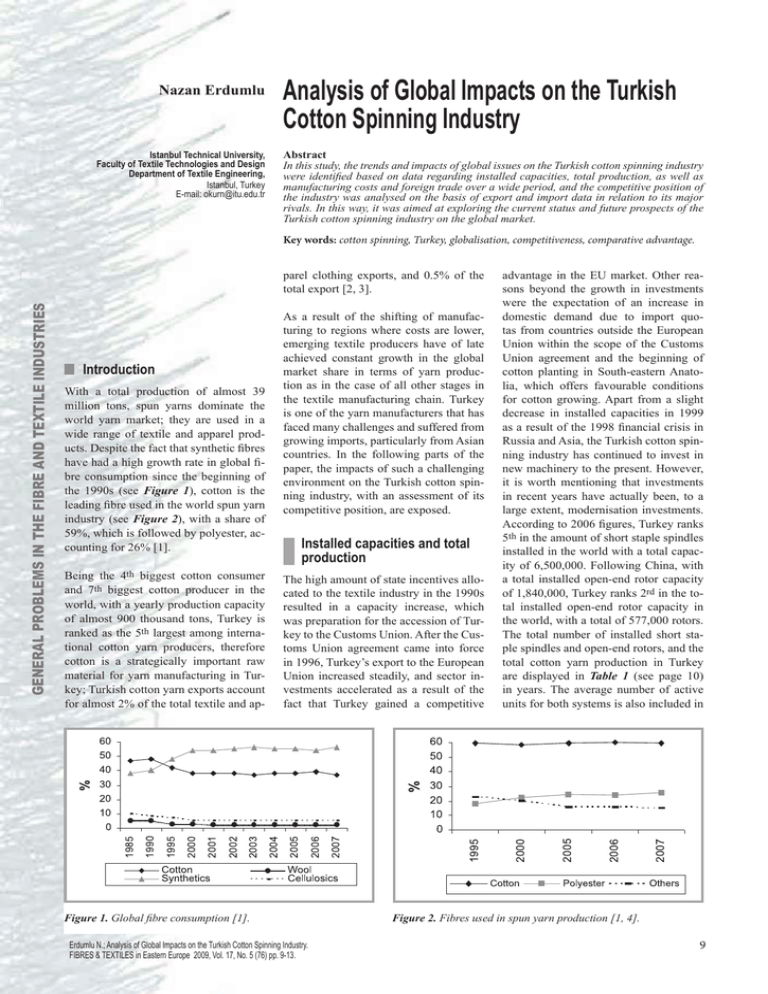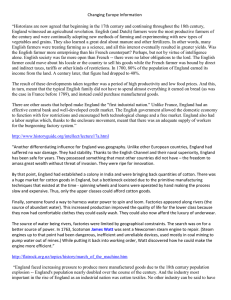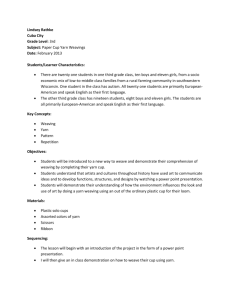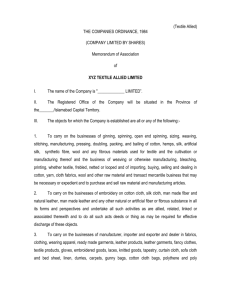Analysis of Global Impacts on the Turkish Cotton Spinning Industry Nazan Erdumlu
advertisement

Nazan Erdumlu Istanbul Technical University, Faculty of Textile Technologies and Design Department of Textile Engineering, Istanbul, Turkey E-mail: okurn@itu.edu.tr Analysis of Global Impacts on the Turkish Cotton Spinning Industry Abstract In this study, the trends and impacts of global issues on the Turkish cotton spinning industry were identified based on data regarding installed capacities, total production, as well as manufacturing costs and foreign trade over a wide period, and the competitive position of the industry was analysed on the basis of export and import data in relation to its major rivals. In this way, it was aimed at exploring the current status and future prospects of the Turkish cotton spinning industry on the global market. Key words: cotton spinning, Turkey, globalisation, competitiveness, comparative advantage. GENERAL PROBLEMS IN THE FIBRE AND TEXTILE INDUSTRIES parel clothing exports, and 0.5% of the total export [2, 3]. n Introduction With a total production of almost 39 million tons, spun yarns dominate the world yarn market; they are used in a wide range of textile and apparel products. Despite the fact that synthetic fibres have had a high growth rate in global fibre consumption since the beginning of the 1990s (see Figure 1), cotton is the leading fibre used in the world spun yarn industry (see Figure 2), with a share of 59%, which is followed by polyester, accounting for 26% [1]. Being the 4th biggest cotton consumer and 7th biggest cotton producer in the world, with a yearly production capacity of almost 900 thousand tons, Turkey is ranked as the 5th largest among international cotton yarn producers, therefore cotton is a strategically important raw material for yarn manufacturing in Turkey; Turkish cotton yarn exports account for almost 2% of the total textile and ap- As a result of the shifting of manufacturing to regions where costs are lower, emerging textile producers have of late achieved constant growth in the global market share in terms of yarn production as in the case of all other stages in the textile manufacturing chain. Turkey is one of the yarn manufacturers that has faced many challenges and suffered from growing imports, particularly from Asian countries. In the following parts of the paper, the impacts of such a challenging environment on the Turkish cotton spinning industry, with an assessment of its competitive position, are exposed. Installed capacities and total production The high amount of state incentives allocated to the textile industry in the 1990s resulted in a capacity increase, which was preparation for the accession of Turkey to the Customs Union. After the Customs Union agreement came into force in 1996, Turkey’s export to the European Union increased steadily, and sector investments accelerated as a result of the fact that Turkey gained a competitive Figure 1. Global fibre consumption [1]. Erdumlu N.; Analysis of Global Impacts on the Turkish Cotton Spinning Industry. FIBRES & TEXTILES in Eastern Europe 2009, Vol. 17, No. 5 (76) pp. 9-13. advantage in the EU market. Other reasons beyond the growth in investments were the expectation of an increase in domestic demand due to import quotas from countries outside the European Union within the scope of the Customs Union agreement and the beginning of cotton planting in South-eastern Anatolia, which offers favourable conditions for cotton growing. Apart from a slight decrease in installed capacities in 1999 as a result of the 1998 financial crisis in Russia and Asia, the Turkish cotton spinning industry has continued to invest in new machinery to the present. However, it is worth mentioning that investments in recent years have actually been, to a large extent, modernisation investments. According to 2006 figures, Turkey ranks 5th in the amount of short staple spindles installed in the world with a total capacity of 6,500,000. Following China, with a total installed open-end rotor capacity of 1,840,000, Turkey ranks 2rd in the total installed open-end rotor capacity in the world, with a total of 577,000 rotors. The total number of installed short staple spindles and open-end rotors, and the total cotton yarn production in Turkey are displayed in Table 1 (see page 10) in years. The average number of active units for both systems is also included in Figure 2. Fibres used in spun yarn production [1, 4]. 9 Table 1. Installed capacities and production in Turkey by year [6, 7]. 1985 1990 1995 1998 1999 2000 2001 2002 2003 2004 2005 2006 6500 Installed short staple spindles (×1000) 3200 3774 4489 5679 5465 5554 5237 5879 6338 6312 6419 Annual change, % 1.88 -3.23 6.40 5.52 -3.77 1.63 3.30 4.21 6.00 -0.40 1.69 1.27 95.00 95.39 97.30 98.43 97.90 98.72 99.14 98.79 99.39 99.43 99.15 98.92 Active during year, % OE rotors (×1000) 25 125 250 418 415 430 460 507 525 543 553 577 Annual change, % 23.76 23.49 19.58 7.73 -0.74 3.74 6.78 10.31 3.55 3.49 1.71 4.41 Active during year, % 90.00 100.00 98.20 100.00 100.00 100.00 99.76 99.79 98.53 97.62 98.54 97.05 310 526 630 898 913 1005 905 1215 1250 1230 1220 1250 Total production (×1000 tons) the table as a percentage of the total installed units [5, 6]. material and power costs, and subsequently to the labour costs. In conjunction with the increase in installed capacities in the 1990s, cotton yarn production rose with an average annual rate of almost 7.3% within the same period. Right after a marked decrease in 2001 due to the effect of the financial crisis in November 2000, as a contraction in domestic demand, the total cotton yarn production in Turkey reached an average amount of approximately 1,230,000 tons in the following years with slight changes. Despite the increasing installed capacity in the past few years, the relatively stable production can be mainly ascribed to high input costs, an overvalued Turkish Lira and, hence, an increase in imports [7]. Whilst China has the advantage in terms of labour cost, its total yarn manufacturing cost is higher than most of the important yarn manufacturing countries in the world. The cost of ring spun yarn manufacturing in Turkey is below the average, and Turkey seems to remain competitive with regard to the total cost of ring yarn manufacturing. On the other hand, the cost of open-end rotor spun yarn manufacturing in Turkey is above the average of the seven countries mentioned. As can be seen from Figure 3, India is the most competitive manufacturer in terms of total yarn manufacturing costs in the world and is the leading country in the import of cotton yarn to Turkey, with a weight of 57,512,323 kg [9]. n Manufacturing costs Table 2 shows the total manufacturing costs of ring and open-end rotor spun yarns for seven important cotton yarn manufacturers in the world. The most important component in the cost of cotton yarn manufacturing is that of raw material, with an average percentage of 50.9 for ring spun yarn, and 69.1 for open-end rotor spun yarn for the group of countries considered. With regard to both ring and open-end rotor spun yarn manufacturing costs, Turkey has the second lowest cost percentage (excluding raw material costs) after China, as shown in Tables 2 and 3. On the other hand, the percentage of raw material costs in the total cost of both ring and open-end rotor spun yarns is significantly high in Turkey. As regards capital costs, which is the second highest component in the total manufacturing cost, Turkey is the most advantageous country. Despite the fact that profits vary across countries, Turkey’s difficulties in competing with respect to price should be evaluated by referring to the high raw 10 n Foreign trade The data used in the present study were gathered from the Commodity Trade Statistics Database of the United Nations Statistics Division. According to SITC Rev 3, subgroup 651.3 - Cotton yarn, other than sewing thread, was included in the analysis with the following basic headings: 651.31 -containing 85% or more by weight of cotton, put up for retail sale 651.32 -other, put up for retail sale 651.33 -containing 85% or more by weight of cotton, not put up for retail sale 651.34 -containing less than 85% by weight of cotton, not put up for retail sale Export and import quantities of the Turkish cotton spinning industry between 1985 and 2007 are shown in Figure 4. Cotton yarn import was considerably low until 1990, while in the same period, the export rate was comparatively high as a consequence of export oriented industrialisation policies based on free market economics. By 1990, exports had decreased despite a marked increase in cotton yarn production, whilst imports began to increase. The considerable devaluation of the Turkish Lira and the contraction in domestic demand resulted in a marked increase in exports in 1994, but decreased immediately after by almost 46%. However, with accelerated production after 1995, positively reflected in Turkey’s cotton yarn export, the industry recorded a foreign trade surplus until 2002. The most striking aspect of the period after 2002 up to the present is the outstanding increase in cotton yarn imports, which indicates the transition of the Turkish textile and, particularly, clothing industry into an import based manufacturing structure [7, 9]. The increase in cotton yarn imports between 2003 and 2007 has caused domestic cotton yarn manufacturers to be unable to compete under these circumstances and has consequently forced the government to take precautions against an unfair competitive environment. For this reason in order to ensure to remove the severe loss and severe loss threat of the increase in imports and import conditions on domestic production, a supplementary financial obligation on cotton yarn imports was put into force by decision of the Council of Ministers as a safeguard measure on October 21st, 2008 The product, subject to application, is classified under the Customs sub-headings given below, within the Turkish Customs Tariff Schedule: 52.05 Cotton Yarn (other than sewing thread), containing 85 % or more by weight of cotton, not put up for retail sale. 52.06 Cotton Yarn (other than sewing thread), containing less than 85 % by weight of cotton, not put up for retail sale. FIBRES & TEXTILES in Eastern Europe 2009, Vol. 17, No. 5 (76) Table 2. Total costs of ring and OE yarn in 2006 [8]. Particular and total cost Ring spun yarn OE rotor spun yarn Brazil China India Italy Waste, USD/kg yarn 0.20 0.26 0.15 0.19 0.20 Labour, USD/kg yarn 0.08 0.03 0.04 0.77 Power, USD/kg yarn 0.17 0.27 0.32 0.35 Auxiliary material, USD/kg yarn 0.10 0.10 0.10 Capital, USD/kg yarn 0.75 0.43 0.44 Manufacturing cost, USD/kg yarn 1.29 1.09 Raw material, USD/kg yarn 1.36 Raw material, % Total cost, USD/kg yarn Korea Turkey USA Brazil China India Italy 0.21 0.18 0.09 0.12 0.07 0.09 0.09 0.09 0.23 0.19 0.50 0.02 0.01 0.01 0.18 0.06 0.05 0.11 0.20 0.28 0.15 0.08 0.13 0.16 0.18 0.10 0.14 0.08 0.12 0.11 0.10 0.11 0.08 0.08 0.08 0.08 0.08 0.08 0.08 0.46 0.45 0.41 0.65 0.30 0.18 0.18 0.20 0.19 0.17 0.27 1.05 1.89 1.18 1.19 1.59 0.57 0.52 0.50 0.72 0.51 0.53 0.62 1.80 1.08 1.31 1.36 1.42 1.22 1.28 1.76 1.02 1.24 1.29 1.36 1.13 51 62 51 41 54 54 43 69 77 67 63 72 72 64 2.65 2.89 2.13 3.20 2.54 2.61 2.81 1.85 2.28 1.52 1.96 1.80 1.89 1.75 a) Korea Turkey USA 0.08 b) Figure 3. Total costs of ring (a) and OE (b) yarn 2006 in USD/kg yarn. 52.07 Cotton Yarn (other than sewing thread) put up for retail sale. According to the decision of the Council of Ministers, until 14.7.2009, a 20% supplementary financial obligation, 19% and 18% for the following two years, will be collected: no more than 1 USD/kg, 0.95 USD/kg, and 0.90 USD/kg, and no lower than 0.35 USD/kg, 0.33 USD/kg and 0.31 USD/kg, respectively [10]. Competitiveness of the industry The competitiveness of the Turkish cotton spinning industry in comparison with major manufacturers was analysed by applying the Revealed Comparative Advantage (RCA) index developed by Balassa, which is also known as the Balassa index, and Vollrath’s measures of competitiveness, which include the relative export advantage index (RXA), the relative import advantage index (RMA), the relative trade advantage index (RTA) and the relative competitiveness index (RC). They are calculated by using the following formulas [11]: RCAij = (Xij/ Xj) / (Xiw / Xw) RXAij = (Xij/ Xnj) / (Xir / Xnw) FIBRES & TEXTILES in Eastern Europe 2009, Vol. 17, No. 5 (76) RMAij = (Mij / Mnj) / (Mir / Mnr) RTAij = RXAij – RMAij RCij = ln(RXAij) – ln(RMAij) where, Xij exports of commodity/industry i of country j Xj total exports of country j Xiw world exports of commodity/industry i Xw total world exports X exports M imports n rest of the commodities r rest of the world Vollrath’s relative export advantage index (RXA) differs from the Ballasa index by allowing one to distinguish between a specific commodity/country and the rest of the commodities/countries. The indices developed by Vollrath eliminate the country and commodity double counting in world trade [11 - 13]. Using the data gathered from the Commodity Trade Statistics Database of the United Nations Statistics Division regarding subgroup 651.3, RCA, RXA, RTA and RC indices were calculated, the results of which are given in Tables 3 - 6. Figure 4. Quantities of Turkish cotton yarn exports and imports of [9]. 11 The analysis of Turkey’s comparative advantage in cotton yarn on the basis of the Balassa index showed that this advantage decreased over the period between 2000 and 2007. The results in Table 3 show that the revealed comparative advantage for Pakistan and India are greater than for Turkey for the entire period considered. Actually, a decreasing trend in comparative advantage can be observed for the majority of the countries, apart from Pakistan, India and the USA, in the past few years, indicating that the percentage of cotton yarn exports in the total exports of the countries stated has increased on the value basis. According to Vollrath, the positive values of the indices indicate a comparative advantage, whereas negative values indicate a comparative disadvantage [11 - 13]. As in the case of the revealed comparative advantage, Turkey has a decreasing relative export advantage in the cotton spinning industry. Turkey’s relative trade advantage indices within the period of 2000 - 2007 verified the increase in the import rate and indicated a relative disadvantage existing by the year 2007. Similarly, Vollrath’s revealed competitiveness index (RC) for Turkey also showed a decreasing trend from 2000, turning into a competitive disadvantage in 2007. The results of the analysis identified that among the cotton yarn exporting countries, Pakistan has the highest relative export and trade advantage, and revealed competitiveness. The variations in the competitive position with respect to all types of indices across the years means that the cotton spinning industry in Turkey has been affected in a negative manner by intensified price based competition on the global market. n Discussion and conclusion The competitive power of the Turkish textile and clothing industry is based on the fact that Turkey is an important cotton producer, and it has well-developed sub-sectors with advanced technology and infrastructure throughout all the stages in the textile and clothing manufacturing chain. Therefore, it is inevitable for the cotton spinning industry to become more competitive in the upcoming years. However, most of the manufacturers in Turkey have recently stopped produc- 12 Table 3. Balassa’s revealed comparative advantage indices (RCA). Country Turkey Pakistan India 2000 2001 2002 2003 2004 2005 2006 8.25 7.91 4.66 4.55 5.00 4.32 3.73 2007 2.77 107.47 100.47 84.56 74.48 87.43 93.20 107.60 113.82 27.21 22.71 20.64 18.22 15.30 17.31 16.45 17.77 Indonesia 4.17 4.63 4.21 4.62 5.52 4.19 4.19 3.72 China 2.25 2.41 2.78 2.83 2.41 2.24 2.36 2.28 Italy 1.69 1.55 1.43 1.32 1.30 1.26 1.20 1.21 USA 0.33 0.33 0.40 0.56 0.71 0.80 0.90 1.07 Rep. of Korea 0.68 0.69 0.64 0.48 0.47 0.48 0.35 0.38 Brasil 0.81 0.61 0.98 1.27 0.86 0.63 0.51 0.27 2007 Table 4. Vollrath’s relative export advantage indices (RXA). Country Turkey Pakistan India 2000 2001 2002 2003 2004 2005 2006 8.57 8.24 4.72 4.66 5.15 4.42 3.80 2.81 141.96 130.82 105.45 90.63 107.42 115.76 136.26 142.35 33.83 27.16 24.70 21.39 17.50 20.61 19.58 21.47 Indonesia 4.31 4.79 4.34 4.76 5.71 4.31 4.31 3.81 China 2.36 2.56 3.04 3.16 2.64 2.45 2.65 2.57 Italy 1.73 1.58 1.45 1.34 1.31 1.27 1.21 1.21 USA 0.31 0.30 0.37 0.54 0.69 0.78 0.90 1.08 Rep. of Korea 0.67 0.69 0.63 0.47 0.46 0.47 0.34 0.37 Brasil 0.81 0.61 0.84 1.28 0.86 0.62 0.51 0.27 2007 Table 5. Vollrath’s relative trade advantage indices (RTA). Country 2000 2001 2002 2003 2004 2005 2006 6.54 6.31 2.24 1.13 2.13 1.25 1.15 -2.29 141.96 130.82 105.43 90.47 106.61 115.13 135.78 142.01 33.70 27.03 24.54 21.30 17.42 20.49 19.41 21.29 2.65 3.17 2.77 3.25 4.39 3.16 3.28 2.71 China -2.23 -2.31 -1.91 -1.07 -0.87 -1.65 -1.76 -1.57 Italy -0.26 -0.38 -0.36 -0.51 -0.28 -0.38 -0.74 -0.74 USA 0.01 0.06 0.13 0.30 0.38 0.51 0.63 0.90 -2.69 -2.97 -2.84 -2.37 -2.35 -2.12 -2.56 -2.15 0.39 0.44 0.71 1.16 0.64 0.25 0.16 -0.59 Turkey Pakistan India Indonesia Rep. of Korea Brasil Table 6. Vollrath’s revealed competitiveness indices (RC). Country Turkey Pakistan 2000 2001 2002 2003 2004 2005 2006 2007 1.44 1.45 0.65 0.28 0.53 0.33 0.36 -0.60 10.60 12.71 8.49 6.32 4.89 5.21 5.65 6.02 India 5.55 5.34 5.02 5.53 5.38 5.19 4.71 4.79 Indonesia 0.96 1.09 1.02 1.15 1.46 1.33 1.43 1.25 China -0.67 -0.64 -0.49 -0.29 -0.29 -0.52 -0.51 -0.48 Italy -0.14 -0.22 -0.22 -0.33 -0.19 -0.26 -0.48 -0.48 USA 0.02 0.20 0.44 0.80 0.80 1.06 1.23 1.81 -1.61 -1.67 -1.71 -1.80 -1.81 -1.71 -2.15 -1.92 0.66 1.30 1.91 2.40 1.40 0.50 0.38 -1.16 Rep. of Korea Brasil tion, with some factories having been closed down. The negative course experienced in the Turkish cotton spinning industry in recent years with regard to both domestic and foreign markets has been mainly caused by the high rate of import penetration due to challenging competition arising as a consequence of world trade liberalisation as well as high input costs and an over- valued Turkish Lira. Due to subsidies in yarn manufacturing in rival countries, as well as low manufacturing costs, unit import prices have been steadily decreasing, and therefore, as an intermediate product, the import of cotton yarn has increased in recent years; in 2007, imports of cotton yarn increased dramatically by 102%, reaching 503,479,029 USD in Turkey. Besides, an overvalued Turkish Lira and low tax rates on imported inputs that are FIBRES & TEXTILES in Eastern Europe 2009, Vol. 17, No. 5 (76) subject to export according to the inward processing regime are also highlighted as important factors behind the surge in cotton yarn imports [14, 15]. The relocation of production in regions where labour costs are low has been widely accepted as a survival solution against the effects of the liberalisation of world trade; however, yarn manufacturing is a capital intensive industry, and strategies for yarn manufacturing should be constituted by considering not only labour costs but also raw material costs and availability, capital costs, power costs, as well as labour and machine productivity. The weakness of Turkey in terms of the cost of cotton yarn manufacturing is caused mainly due to the high cost of raw material, which is followed by high power and labour costs, respectively, when compared to top manufacturers. The most remarkable development designed to support domestic production has been the supplementary financial obligation on cotton yarn imports that was put into force in October 2008 for a period of three years. However, the lowering of manufacturing costs is strongly needed in order to achieve a continuous advantage in terms of production. In addition, although recent investments are declared to be for modernisation, an increase in installed capacity as opposed to a stable production rate and considerable increase in imports would appear to be an inappropriate approach to enhance competitive power. In conclusion, the analysis based on foreign trade data of the Turkish cotton spinning industry has highlighted that the comparative advantage and competitiveness of the industry has exhibited a gradually decreasing pattern, even turning into a disadvantage by 2007. Enhancing the competitiveness of the Turkish cotton spinning industry is unavoidable in order to that the Turkish textile and clothing industry become competitive once again as a whole on a global scale. However, in view of the current circumstances, focusing on the development and production of high value added, customer oriented goods should be the priority in order to gain a competitive advantage, since competing in low value added standard bulk products is getting difficult and even impossible. Such an approach calls for target oriented investments and renovations for enabling finer, high quality, innovative and specialised yarn production by considering the advancements FIBRES & TEXTILES in Eastern Europe 2009, Vol. 17, No. 5 (76) being made in spinning technology, deep research and development competencies and strategic partnership alliances. Finally, government support through regulations, incentives and policies as well as the efforts of non-governmental organisations should be developed by considering the interactions among all subsectors, aiming to reconstruct the Turkish textile and clothing industry entirely. References 1. Oerlikon Saurer Management AG, “The Fiber Year 2007/08”, Issue 8, May 2008. 2. T.R. Undersecretariat of Prime Ministry for Foreign Trade, Export Promotion Center, “Elyaf & İplik”, 2008. 3. Celik, A., “A Study on Determining the Profile of Production Sector of Turkish Cotton Yarn Based on 2004 Datum”, MSc. Thesis, Dokuz Eylul University, Izmir 2005. 4. Oerlikon Saurer Management AG, “The Fiber Year 2006/07”, Issue 7, May 2007. 5. Atik, A.H., “Cotton Yarn Industry”, Turkish Development Bank, Industrial Survey, July 1999, Ankara. 6. International Textile Machinery Shipment Statistics, International Textile Manufacturers Federation (ITMF) 1984-2006. 7. Country Statements, International Textile Manufacturers Federation (ITMF), 1985-2007. 8. International Production Cost Comparison, International Textile Manufacturers Federation (ITMF), 2006. 9. http://comtrade.un.org. 10. Council of Ministers Decision, Official Gazette, No: 27031, October 21st 2008. 11. Havrila, I., Gunawardana, P.; “Analysing Comparative Advantage and Competitiveness: An Application to Australia’s Textile and Clothing Industries”, Australian Economic Papers,Vol. 42 Issue 1, pp. 103-117, 2003. 12. Fertö, I., Hubbard, L. J.; “Revealed Comparative Advantage and Competitiveness in Hungarian Agri-Food Sectors”, The World Economy, Vol. 26 Issue 2, pp. 247-259, 2003. 13. Khorchurklang, S., “Factors Influencing Australia’s Dairy������������������������� ������������������������ Product Exports to Thailand: 1980-2002”, PhD. Thesis, Victoria University, Australia, 2005. 14. Hedef Periodicals, No: 176, 15th August - 15th September, 2008. 15. T.R. Prime Ministry, State Planning Organization, 9th Development Plan, Textile, Leather and Clothing Industry Specialization Commission Report, Ankara 2007. Received 11.10.2008 Reviewed 13.05.2009 13




